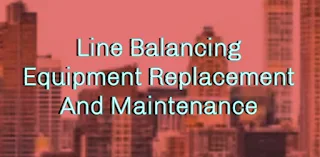Line Balancing Equipment Replacement And Maintenance
Line balancing, equipment replacement, and maintenance are critical aspects of facility management, particularly in manufacturing and production settings. Let's explore each of these concepts in more detail:
1. Line Balancing:
Line balancing is the process of optimizing the production line to ensure that workstations or tasks have a relatively equal amount of work to perform. The goal is to prevent bottlenecks and minimize idle time, thereby improving efficiency and productivity. In manufacturing, a production line typically consists of a sequence of workstations, each performing specific tasks.
The steps involved in line balancing include:
- Identifying the tasks required to produce a product or complete a process.
- Determining the time required to perform each task at each workstation.
- Assigning tasks to workstations in a way that minimizes the difference in workloads and cycle times between workstations.
Line balancing helps streamline production, reduces wait times, and ensures that each workstation operates at its optimal capacity. It may involve rearranging tasks, adding or removing workstations, or adjusting the workforce at different points in the production process.
2. Equipment Replacement:
Equipment replacement refers to the process of systematically replacing older or obsolete machinery, tools, or equipment with newer and more efficient ones. This is crucial to maintain a competitive edge, improve productivity, reduce downtime, and lower maintenance costs.
Factors to consider when deciding on equipment replacement include:
- Age and condition of the existing equipment.
- Repair and maintenance costs of the current equipment.
- Technological advancements and new features offered by modern equipment.
- Potential gains in productivity and energy efficiency with the new equipment.
- Return on investment (ROI) and the overall financial impact of the replacement.
Regularly upgrading equipment ensures that the facility remains efficient, reduces the likelihood of breakdowns, and keeps pace with industry standards and advancements.
3. Equipment Maintenance:
Equipment maintenance involves a series of proactive actions taken to preserve the condition and performance of machinery, tools, and equipment. Proper maintenance ensures that assets remain operational, minimize downtime, and extend their useful life. There are various maintenance strategies, including preventive maintenance, predictive maintenance, and corrective maintenance:
- Preventive Maintenance: Regularly scheduled inspections, cleaning, and servicing to prevent breakdowns and identify potential issues before they cause significant problems.
- Predictive Maintenance: Using data and condition monitoring to predict when maintenance is required, based on equipment performance indicators.
- Corrective Maintenance: Addressing equipment failures or breakdowns after they occur.
Effective equipment maintenance requires keeping accurate records, training staff on proper handling and care, and having contingency plans for emergencies.
In summary, line balancing, equipment replacement, and maintenance are interconnected elements of facility management, with the shared goal of optimizing productivity, reducing costs, and ensuring a smooth and efficient operation. Regularly evaluating and improving these aspects will contribute to the overall success of the facility or manufacturing process.









0 Comments